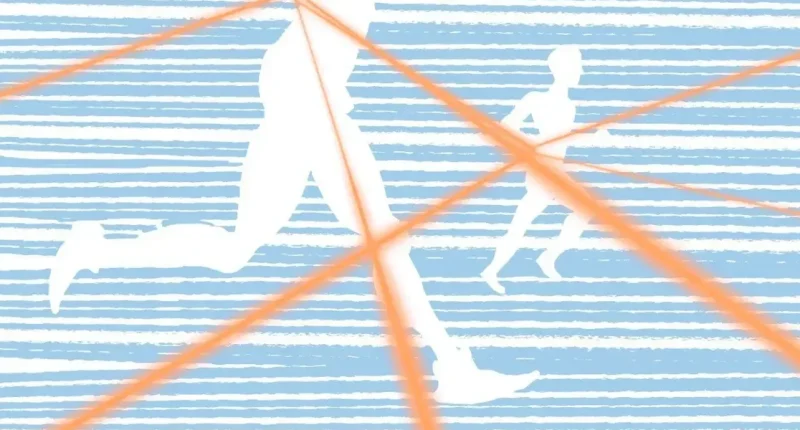Editor’s Note: This piece originally appeared in the print version of Return.
Time for what?
The watch wakes you with a gentle buzz: Two minutes until the alarm goes off in the next room.
The alarm in the next room is a generic contrivance against sleeping in, a data point in a broader network of calendar appointments, reminders, and notifications, all centralized in a smartphone. It calls your attention to the time but without any specific purpose: “Time to get up.” Get up for what? There is no response. The smartphone is dumb.
But the watch’s gentle buzz is different. It says something specific: “Time to run.”
Rising to run in the morning is immediately a social deed, even if it’s a solo run. The watchful buzz is a reminder that someone else is already out there, getting up, lacing up, getting after it. With or without coffee, over the elegant brick streets and past the manicured gardens of privilege or across the broken asphalt and wreckage of urban blight, someone else’s feet are already at work, pacing out the steps of that first mendacious mile.
The first mile of every run is usually a big lie: Stiffness masquerades as pain, sleepiness pretends to be central nervous system exhaustion, and every bad turn of the foot seems a sure omen of an injury to come or a bad run. The higher the weekly mileage, the fitter the athlete, the more the first mile lies. In this hardest of miles, the tech of the watch becomes your ally. By meticulously monitoring your speed, the cadence of your feet, and the beating of your heart, the tech reminds you that this first mile is always slow, always clumsy, always harder than the second. It reminds you, too, that someone else has already run the first mile today — or is taking his first steps virtually at your side.
It’s never just “someone else” who is running with you, though. Maybe before the smartwatch, it was just “someone” — or even no one — who was by your virtual side on those solo runs. But now they have names: Chris, Matt, Carl, Dan, Al, and Will. They’re your friends, your rivals, your nemeses, and they are always with you because, as runners say only half-jokingly, a run doesn’t count if it isn’t on Strava.
Kudos are king of all
Strava is the addictive fitness app that pretty much every competitive runner and cyclist uses to track work and measure themselves against others. It syncs with your smartwatch to track your mileage, pace, heart rate, and many other metrics, and it measures your progress and personal records. It also maps where you run or ride, lighting up the map in bright orange with stats on elevation gain, distance, and relative difficulty adjusted for the steepness of your ascent.
Men will die for Strava miles, and perhaps they actually have. In 2018, Strava made the highly questionable decision to publish its users’ 13 trillion GPS data points online. It was a marketing ploy to showcase the strong appeal and adoption of the app. But it turns out that the adoption of Strava was more widespread than even its owners knew and that its users were more devoted than even the app’s engineers realized. Soldiers, special forces troops, and intelligence operatives around the world posted all of their runs and workouts to Strava religiously. By publishing their routes, Strava inadvertently revealed the location of U.S., French, and Nigerian military camps and intelligence facilities around the world. CIA “black sites” that had remained opaque to enemy surveillance for years were suddenly lit up in bright orange blueprints for all the world to see. Strava has since considerably increased its focus on user privacy.
Why did America’s soldiers and spies post every last run, lift, and swim to a GPS-enabled app that syncs to the web? They did it for the kudos, of course.
Like Facebook and other social media, Strava’s notification button lights up red to draw you in, promising a rush of serotonin. But where Facebook users live for “likes,” Strava’s currency is “kudos,” congratulations or compliments, which comes from the Greek word kudos, which means “glory for a great deed.”
Kudos are as addictive as likes, but the addiction is different — and helpful.
Because every post is based on real physical activity, your followers don’t hand out kudos indiscriminately. Every runner has a handful of followers (or a lot of followers) who praise him for every activity, and there’s nothing wrong with that; it’s the virtual equivalent of friends high-fiving after an easy jog and saying, “Good run.” But to get a lot of kudos, you have to do something unprecedented for yourself (like a big personal record or PR), something simply impressive to everyone (like winning a race), or something that is just kind of crazy (like running 24 miles on New Year’s Eve and 25 miles on New Year’s Day — because it wouldn’t do to start the year off by going backward).
The ancient Greeks had a saying: nomos panton basileus: “Custom is king of all.” For the modern athlete, kudos are king of all. The two sayings are closer than they seem.
The customs of the ancient cities were the works of men who were equal citizens. Still, they were based on the recognition that a natural hierarchy must be respected: The customs constituted the law of the ancient city, honoring the nobler and condemning the base.
Strava kudos are trivial by comparison, addressed as they are to coffee rides and fun runs, but they are very similar in structure; they are human honors rendered in response to a hierarchy of natural excellence. In its own little way, Strava, more than any other modern app, might have a better claim to having built an aristocracy.
The most popular social media apps and networks tend to democratize their users — for good or ill. Everyone is, in a sense, equal in the scrum of the comments section, and Facebook’s algorithms strive to make us more so by dragging us toward ever more reductively ideological discourse.
Twitter is more beneficial because it can at least reward users for fostering a diversity of perspectives: Retweets recast a “hot take” rather than merely repeating it dumbly. Because you can retweet, you can “ratio” tweets, making the reimagined version of a speech more popular than the original. This turns the app into a kind of virtual democratic forum — an unruly but egalitarian scrum. Everyone is equal on Twitter, too, because the value of each original tweet has no grounding other than its evaluation by the public; it has no external reference in nature.
Facebook is the social media analog to a mob, and Twitter has the potential to be the social media equivalent of a pure electoral democracy. In that case, Strava comes closest of any app in existence today to the social media version of an aristocracy because the value of its original posts is inextricably tied to actual physical deeds that are intrinsically hierarchical.
Strava’s quasi-aristocratic focus on honor makes life inside its walled garden very different.
Inside Zuckerberg’s walled garden, algorithms reward you for posting rants that infuriate fellow users, driving engagement and artificially expanding your reach to false “friends” with whom you share nothing but ideological prejudice. Facebook’s algorithms are designed for a zero-sum game of attention in which the social network’s number-one rival is the real world and virtual friendships compete for time with real friendships. The Zuckerbots are designed to pull users out of natural reality into an artificial hall of mirrors designed to distort every comment to its ideological extreme.
Strava, too, is all about extremes, but it’s about extreme deeds in the real world. Every Strava post starts with an activity posted from a smartwatch — a run, a ride, a swim, a workout. Entrepreneurs talk blithely about sweat equity, but in Strava, sweat equity is literal: Every post can only be purchased with sweat.
Like Facebook and Twitter, Strava users compete for followers. But relationships with followers are different, too, forged in bonds of often mutual respect — and usually arising from actual physical proximity. The way that most people build their followings is to simply go on a run or a ride. The app automatically groups your activity with that of your friends, using proximity in the natural world as the basis for identifying a digital friendship.
By grounding every post in a natural, real-world activity, the smartwatch tech directs its users’ eyes toward a natural hierarchy rather than a constructed mediocrity. It does more than that: Unlike Facebook, which rewards navel-gazing obsession with social bickering, it draws our attention out into the physical landscape of the natural world.
Running as a physical art of memory
Ryan Pierse/Getty
The physicality of Strava goes beyond human beings: it takes you into a relationship with your city, neighborhood, and land.
I was the world’s worst navigator in the dark days before smartphones. In my defense, I don’t live in an easy city to learn: The grid of Dallas looks like it was laid out with all of the forethought of Epimetheus, and most of the streets in my neighborhood are about as straight as the Stonewall Bar on a Saturday night. But even considering these excuses, I was a particularly hopeless case. On more than one occasion, I would end up at the intersection of Armstrong and Preston, in the heart of the mansions of the Park Cities. My beat-up Honda Civic idled in front of a baroque gate, a fountain, or a manicured lawn (no doubt drawing the suspicious eyes of the Highland Park Police) as I tried vainly to decide which road went back to Irving.
Later, smartphones and maps apps papered over my cognitive weakness, but they never cured it; once the phone battery died, I was as lost as Aguirre up the Amazon River and only in a marginally better mood.
But running the streets of my city changed all of that.
When you run with a smartwatch, every run is outlined on a map. Some users even use their runs as an athletic Etch A Sketch to draw the shape of Texas, a dragon, a heart, or even a sketch of Golgotha for Easter Sunday. The maps can be much more than a goofy lark, though: When you go over them enough, they become an invaluable aide-memoire and a tool for enhancing the faculty of spatial reasoning.
The habit of running routes, reviewing them on my map, and then running them again trained my mind and body. Roads were no longer interchangeable abstractions. They became memories of effort. A road became the memory of a threshold run when my heart rate redlined; a hill became the feeling of lactate flushing the legs; a turn became the feeling of hips extending and feet rebounding off the asphalt as cadence and turnover increased.
Through the tech of maps and the practice of memory, the streets of Dallas are no longer Cartesian data points; they are opportunities for action and possibilities for movement. The result is that my spatial memory and ability to navigate have significantly improved — not only for the streets I’ve run but for all streets, even in other cities I visit for the first time.
The key to this process is that it is sequential and recursive: You start by inscribing the dimensions of nature on your soul with physical activity, without the mediation of tech; you use tech afterward to deepen, cement, and intensify the action of memory. The sequence of natural experience, production of memory, and tech-aided reinforcement of memory multiplies the power of the mind through the body. It opens our eyes to see the natural world more clearly.
The tech of the smartwatch, paired with Strava, makes it possible for human beings to better use their bodies as instruments of memory, tools for inscribing upon their souls the dimensions of the natural world around them. Tech draws men and women out into the world and lets them see it as it ought to be seen — not as a dataset for optimization but as a field for human action.
A road map toward a more human tech?
How do we build a new kind of tech that is better than modern technology, a tech that makes us more rather than less human?
I submit that such a new tech will:
- Help us number our days purposefully and think of time as an action.
- Be grounded in a natural hierarchy and use honor to strengthen that hierarchical order.
- Turn our gaze outwards toward the beauty of a nature that is more than human.
What does the nobler social media network of the future look like?
For the past couple of years, many on the right have tried and striven in vain to build a “Facebook for conservatives,” a “based version of Amazon,” or a “free-speech Twitter” — and hey, maybe we just got one of the three!
But if we want to build a genuinely new, revolutionary tech, we need to take a humbler point of departure, one grounded in the sweat of the brow and the dirt of the road.
What if the tech of the future looks less like “Facebook for Republicans” and more like “Strava — for the soul”?
Also Read More: World News | Entertainment News | Celebrity News









